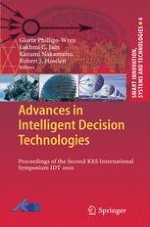Intelligent Decision Technologies (IDT) seeks an interchange of research on intelligent systems and intelligent technologies which enhance or improve decision making in industry, government and academia. The focus is interdisciplinary in nature, and includes research on all aspects of intelligent decision technologies, from fundamental development to the applied system. This volume represents leading research from the Second KES International Symposium on Intelligent Decision Technologies (KES IDT’10), hosted and organized by the Sellinger School of Business and Management, Loyola University Maryland, USA, in conjunction with KES International. The symposium was concerned with theory, design development, implementation, testing and evaluation of intelligent decision systems. Topics include decision making theory, intelligent agents, fuzzy logic, multi-agent systems, Bayesian networks, optimization, artificial neural networks, genetic algorithms, expert systems, decision support systems, geographic information systems, case-based reasoning, time series, knowledge management systems, Kansei communication, rough sets, spatial decision analysis, and multi-criteria decision analysis. These technologies have the potential to revolutionize decision making in many areas of management, healthcare, international business, finance, accounting, marketing, military applications, ecommerce, network management, crisis response, building design, information retrieval, and disaster recovery.
